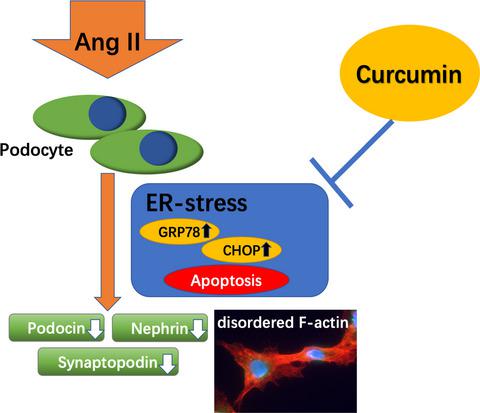当前位置:
X-MOL 学术
›
FEBS Open Bio
›
论文详情
Our official English website, www.x-mol.net, welcomes your
feedback! (Note: you will need to create a separate account there.)
Curcumin attenuates angiotensin II-induced podocyte injury and apoptosis by inhibiting endoplasmic reticulum stress.
FEBS Open Bio ( IF 2.8 ) Pub Date : 2020-08-08 , DOI: 10.1002/2211-5463.12946 Nan Yu 1 , Lin Yang 1 , Lilu Ling 1 , Yuan Liu 1 , Ying Yu 1 , Qing Wu 1 , Yong Gu 1, 2 , Jianying Niu 1
FEBS Open Bio ( IF 2.8 ) Pub Date : 2020-08-08 , DOI: 10.1002/2211-5463.12946 Nan Yu 1 , Lin Yang 1 , Lilu Ling 1 , Yuan Liu 1 , Ying Yu 1 , Qing Wu 1 , Yong Gu 1, 2 , Jianying Niu 1
Affiliation

|
Podocytes are an important component of the glomerular filtration barrier in the kidneys. The dysfunction and apoptosis of podocytes are important factors that can lead to the progression of chronic kidney disease (CKD). In CKD, angiotensin II is continuously elevated in circulation and is considered to have key roles in inducing podocyte injury and apoptosis. Curcumin is a hydrophobic polyphenolic compound extracted from turmeric. Increasing evidence demonstrates that curcumin has a protective effect on the kidneys in CKD. However, the mechanisms mediating this protective effect remain unclear. The aim of this study was to explore whether curcumin could protect against angiotensin II‐induced injury and apoptosis of podocytes. We performed western blotting, immunofluorescence, phalloidin staining, and terminal deoxynucleotidyl transferase nick‐end labeling staining to observe the expression level of podocyte‐specific proteins, apoptosis‐related proteins, and the arrangement of F‐actin. We found that curcumin could reverse angiotensin II‐induced podocyte injury and apoptosis in a dose‐dependent manner. In addition, curcumin dose‐dependently attenuated a pro‐apoptotic pathway, activated by angiotensin II‐induced endoplasmic reticulum stress. Conversely, the protective effects of curcumin were impaired upon addition of tunicamycin, an activator of endoplasmic reticulum stress. Thus, we speculate that curcumin protects against angiotensin II‐induced podocyte injury and apoptosis, at least partly by inhibiting endoplasmic reticulum stress.
中文翻译:

姜黄素通过抑制内质网应激减轻血管紧张素 II 诱导的足细胞损伤和细胞凋亡。
足细胞是肾脏肾小球滤过屏障的重要组成部分。足细胞功能障碍和凋亡是导致慢性肾脏病(CKD)进展的重要因素。在 CKD 中,血管紧张素 II 在循环中持续升高,被认为在诱导足细胞损伤和细胞凋亡中起关键作用。姜黄素是一种从姜黄中提取的疏水性多酚化合物。越来越多的证据表明姜黄素对 CKD 患者的肾脏具有保护作用。然而,介导这种保护作用的机制仍不清楚。本研究的目的是探讨姜黄素是否可以防止血管紧张素 II 诱导的足细胞损伤和凋亡。我们进行了蛋白质印迹、免疫荧光、鬼笔环肽染色、末端脱氧核苷酸转移酶缺口末端标记染色观察足细胞特异性蛋白、凋亡相关蛋白的表达水平和F-肌动蛋白的排列。我们发现姜黄素可以以剂量依赖的方式逆转血管紧张素 II 诱导的足细胞损伤和细胞凋亡。此外,姜黄素剂量依赖性地减弱由血管紧张素 II 诱导的内质网应激激活的促凋亡途径。相反,姜黄素的保护作用在加入衣霉素(一种内质网应激的激活剂)后受损。因此,我们推测姜黄素至少部分通过抑制内质网应激来防止血管紧张素 II 诱导的足细胞损伤和细胞凋亡。和F-肌动蛋白的排列。我们发现姜黄素可以以剂量依赖的方式逆转血管紧张素 II 诱导的足细胞损伤和细胞凋亡。此外,姜黄素剂量依赖性地减弱由血管紧张素 II 诱导的内质网应激激活的促凋亡途径。相反,姜黄素的保护作用在加入衣霉素(一种内质网应激的激活剂)后受损。因此,我们推测姜黄素至少部分通过抑制内质网应激来防止血管紧张素 II 诱导的足细胞损伤和细胞凋亡。和F-肌动蛋白的排列。我们发现姜黄素可以以剂量依赖的方式逆转血管紧张素 II 诱导的足细胞损伤和细胞凋亡。此外,姜黄素剂量依赖性地减弱由血管紧张素 II 诱导的内质网应激激活的促凋亡途径。相反,姜黄素的保护作用在加入衣霉素(一种内质网应激的激活剂)后受损。因此,我们推测姜黄素至少部分通过抑制内质网应激来防止血管紧张素 II 诱导的足细胞损伤和细胞凋亡。由血管紧张素 II 诱导的内质网应激激活。相反,姜黄素的保护作用在加入衣霉素(一种内质网应激的激活剂)后受损。因此,我们推测姜黄素至少部分通过抑制内质网应激来防止血管紧张素 II 诱导的足细胞损伤和细胞凋亡。由血管紧张素 II 诱导的内质网应激激活。相反,姜黄素的保护作用在加入衣霉素(一种内质网应激的激活剂)后受损。因此,我们推测姜黄素至少部分通过抑制内质网应激来防止血管紧张素 II 诱导的足细胞损伤和细胞凋亡。
更新日期:2020-10-02
中文翻译:

姜黄素通过抑制内质网应激减轻血管紧张素 II 诱导的足细胞损伤和细胞凋亡。
足细胞是肾脏肾小球滤过屏障的重要组成部分。足细胞功能障碍和凋亡是导致慢性肾脏病(CKD)进展的重要因素。在 CKD 中,血管紧张素 II 在循环中持续升高,被认为在诱导足细胞损伤和细胞凋亡中起关键作用。姜黄素是一种从姜黄中提取的疏水性多酚化合物。越来越多的证据表明姜黄素对 CKD 患者的肾脏具有保护作用。然而,介导这种保护作用的机制仍不清楚。本研究的目的是探讨姜黄素是否可以防止血管紧张素 II 诱导的足细胞损伤和凋亡。我们进行了蛋白质印迹、免疫荧光、鬼笔环肽染色、末端脱氧核苷酸转移酶缺口末端标记染色观察足细胞特异性蛋白、凋亡相关蛋白的表达水平和F-肌动蛋白的排列。我们发现姜黄素可以以剂量依赖的方式逆转血管紧张素 II 诱导的足细胞损伤和细胞凋亡。此外,姜黄素剂量依赖性地减弱由血管紧张素 II 诱导的内质网应激激活的促凋亡途径。相反,姜黄素的保护作用在加入衣霉素(一种内质网应激的激活剂)后受损。因此,我们推测姜黄素至少部分通过抑制内质网应激来防止血管紧张素 II 诱导的足细胞损伤和细胞凋亡。和F-肌动蛋白的排列。我们发现姜黄素可以以剂量依赖的方式逆转血管紧张素 II 诱导的足细胞损伤和细胞凋亡。此外,姜黄素剂量依赖性地减弱由血管紧张素 II 诱导的内质网应激激活的促凋亡途径。相反,姜黄素的保护作用在加入衣霉素(一种内质网应激的激活剂)后受损。因此,我们推测姜黄素至少部分通过抑制内质网应激来防止血管紧张素 II 诱导的足细胞损伤和细胞凋亡。和F-肌动蛋白的排列。我们发现姜黄素可以以剂量依赖的方式逆转血管紧张素 II 诱导的足细胞损伤和细胞凋亡。此外,姜黄素剂量依赖性地减弱由血管紧张素 II 诱导的内质网应激激活的促凋亡途径。相反,姜黄素的保护作用在加入衣霉素(一种内质网应激的激活剂)后受损。因此,我们推测姜黄素至少部分通过抑制内质网应激来防止血管紧张素 II 诱导的足细胞损伤和细胞凋亡。由血管紧张素 II 诱导的内质网应激激活。相反,姜黄素的保护作用在加入衣霉素(一种内质网应激的激活剂)后受损。因此,我们推测姜黄素至少部分通过抑制内质网应激来防止血管紧张素 II 诱导的足细胞损伤和细胞凋亡。由血管紧张素 II 诱导的内质网应激激活。相反,姜黄素的保护作用在加入衣霉素(一种内质网应激的激活剂)后受损。因此,我们推测姜黄素至少部分通过抑制内质网应激来防止血管紧张素 II 诱导的足细胞损伤和细胞凋亡。











































 京公网安备 11010802027423号
京公网安备 11010802027423号